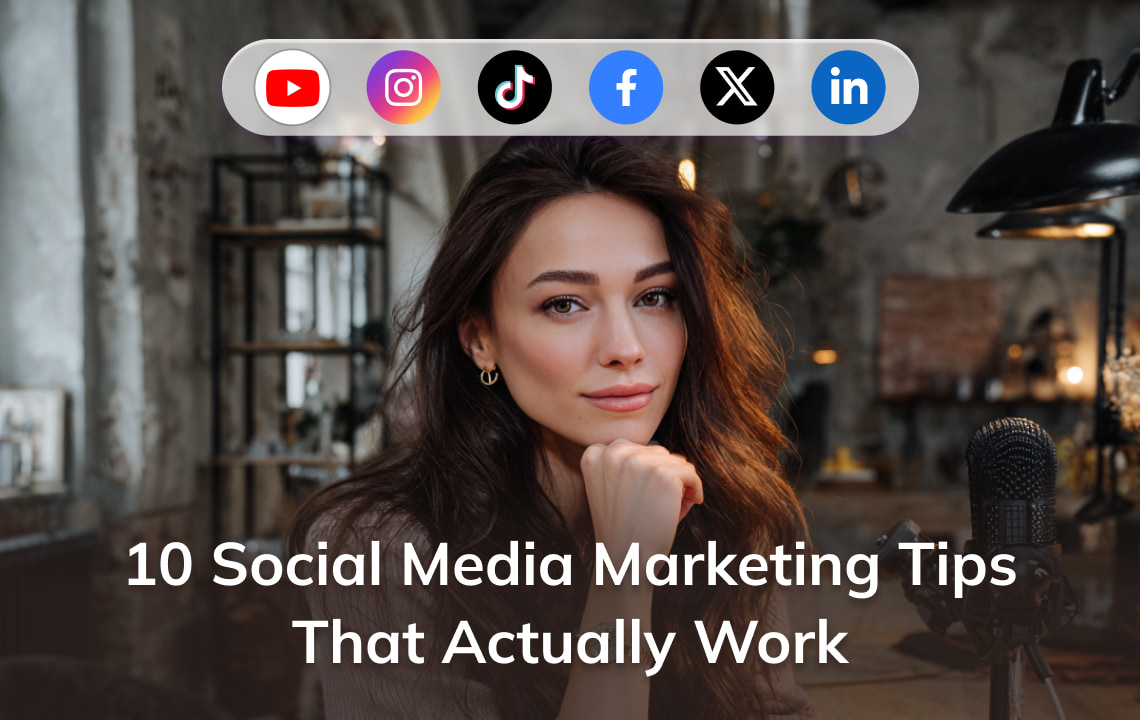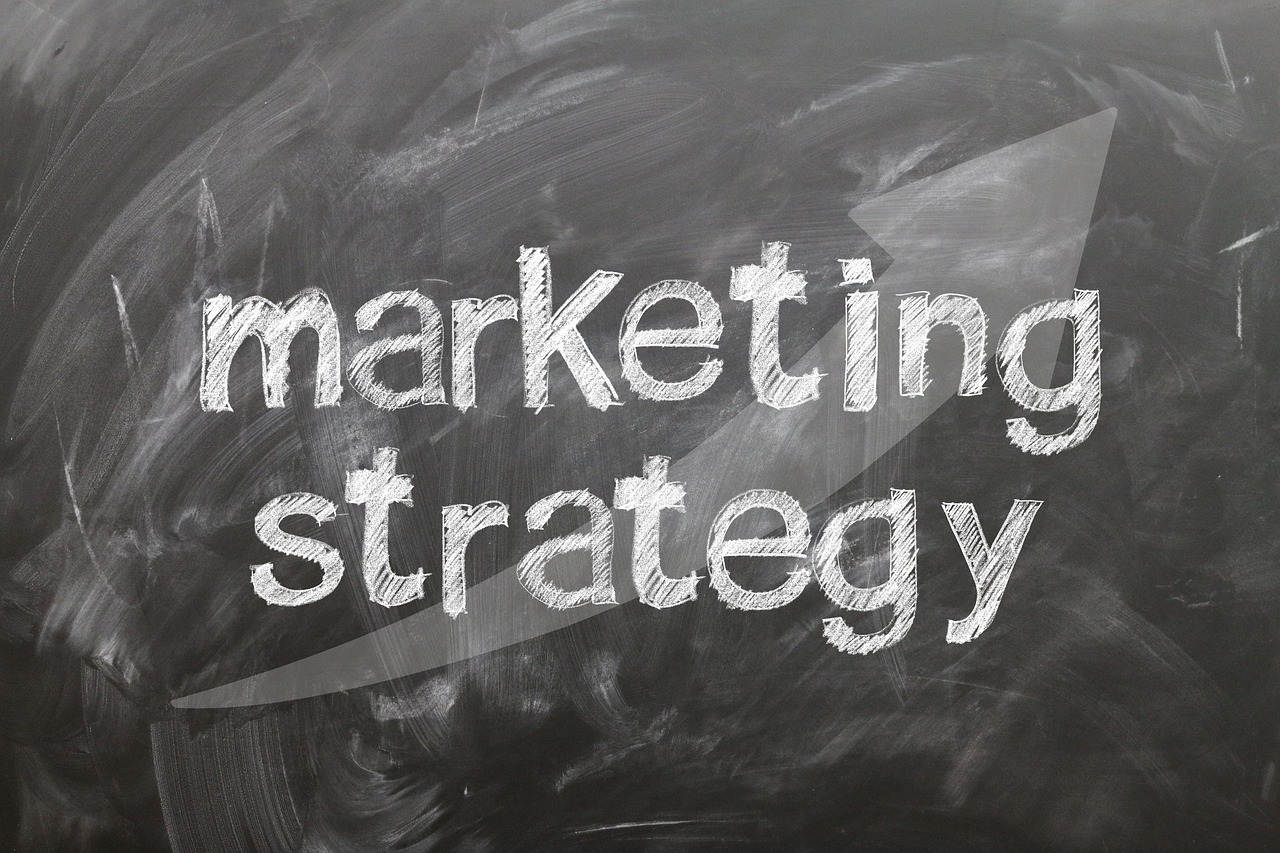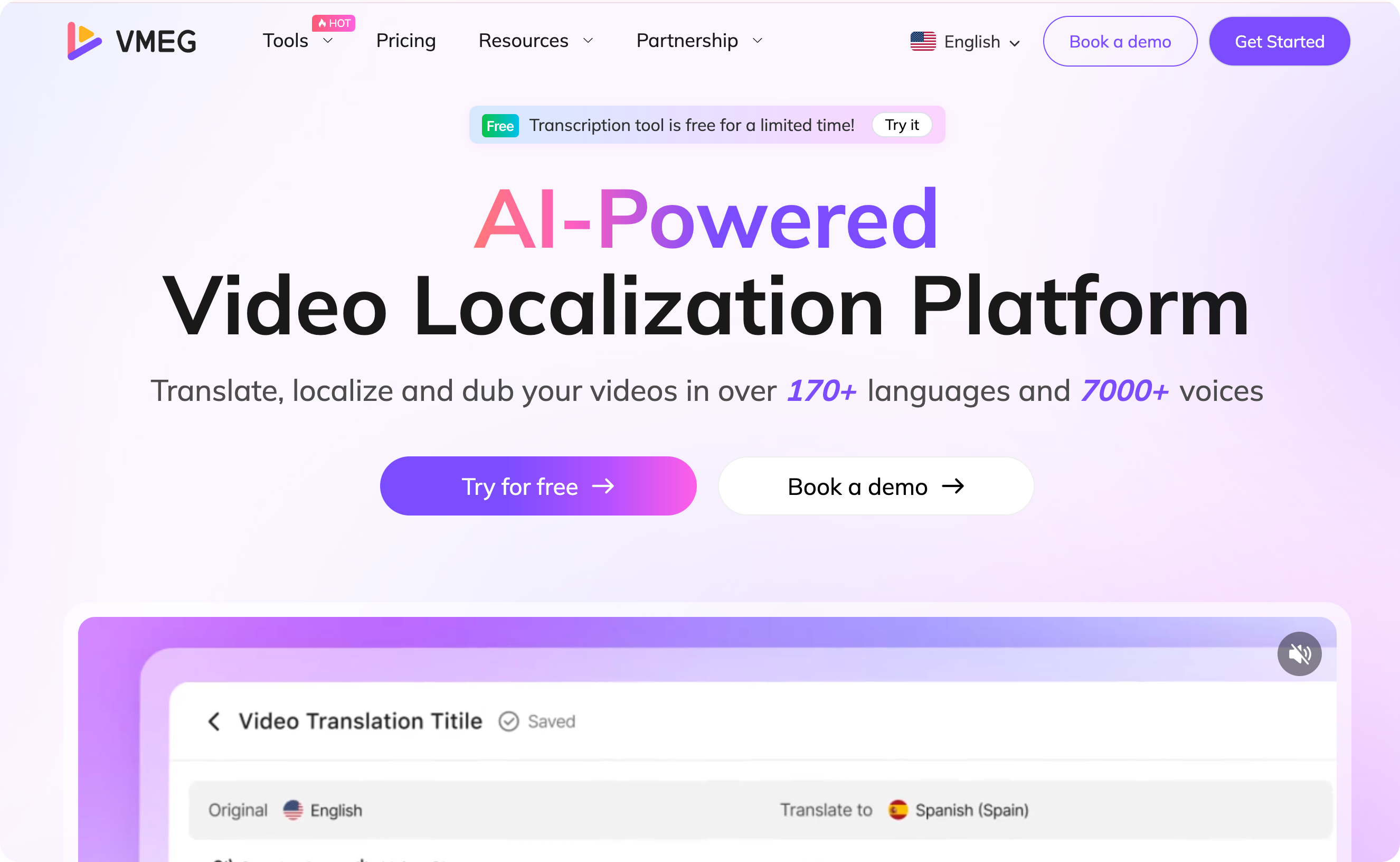
In 2025, social media marketing isn’t just a digital add-on. It’s the heartbeat of brand growth. With over 5 billion active users worldwide and audiences spending more than two hours a day on platforms like TikTok, Instagram, YouTube, and LinkedIn, brands that master social media strategy gain a decisive competitive edge.
Yet as algorithms evolve and attention spans shrink, simply posting more often no longer guarantees engagement. You need a smarter, data-driven, and multilingual approach that connects authentically with audiences across regions.
This comprehensive guide shares 10 proven social media marketing tips to help your brand thrive in today’s fast-changing landscape.
What is Social Media Marketing?
Social media marketing (SMM) refers to the use of social networking platforms and associated tools to build brand awareness, engage with audiences, distribute content, drive traffic and conversions, and foster loyalty.
In a world where more than half of the global population now uses social media (63.9 % as of early 2025) and spends on average around 2h 21m per day on these platforms, these channels have become mission-critical for modern brands.
From organic posts and stories to paid ads, influencer collaborations and community building, SMM spans the full funnel: from discovery → consideration → conversion → advocacy.
In a world where more than half of the global population now uses social media (63.9 % as of early 2025) and spends on average around 2h 21m per day on these platforms, these channels have become mission-critical for modern brands.
From organic posts and stories to paid ads, influencer collaborations and community building, SMM spans the full funnel: from discovery → consideration → conversion → advocacy.
How to Use Social Media Marketing Tips?
| Step | What to Do | Goal/Impact |
| Set Clear Goals | Identify whether your campaign aims for brand awareness, lead generation, sales, or community growth | Ensures all actions align with measurable outcomes |
| Know Your Audience & Context | Research your target demographics, interests, pain points, and platform preferences | Enables more relevant and effective communication |
| Select the Right Platforms | Focus on the few platforms that best match your audience behavior and business objectives | Maximizes ROI and avoids spreading resources too thin |
| Research Topics, Keywords & Formats | Use search trends, social listening, and competitor analysis to identify what your audience actually wants | Produces content that connects and performs |
| Optimize Content | Maintain a consistent brand voice, provide real value, and craft engaging, shareable posts | Builds trust and long-term brand loyalty |
| Leverage UGC & Influencers | Encourage user-generated content and partner with aligned creators or micro-influencers | Expands reach, increases engagement, and adds credibility |
| Go Global | Use AI tools like VMEG.AI for subtitling, dubbing, or translation to reach global audiences | Boosts visibility and cross-market relevance |
| Monitor Competitors & Data | Track competitor activity and measure your own KPIs (views, engagement, conversions, ROI) | Identifies new opportunities and areas for improvement |
| Iterate & Refine | Regularly adjust your strategy based on data insights and evolving platform algorithms | Keeps your brand agile and ahead of trends |
Using this structured approach means your social media efforts are strategic (not ad-hoc), measurable (you know what you're after), and aligned with the realities of 2026’s social landscape.
Tip 1: How to set Social Media Goals?
Start with Your Business Objectives
Every social media goal should directly connect to your broader business goals — such as increasing sales, building brand awareness, generating leads, or improving customer loyalty.
For example, if your company wants to expand into a new market, your social media goal might focus on growing visibility and engagement within that specific region.
Ask yourself:
- What do we want our social presence to achieve for business?
- How does this support our sales, marketing, or customer service priorities?
When your goals tie back to business outcomes, every post or campaign gains a clear strategic purpose.
Use the SMART Framework
The SMART framework ensures that your goals are Specific, Measurable, Achievable, Relevant, and Time-bound.
- Specific: Avoid vague goals like “get more followers.” Instead, say “grow Instagram followers by 20%.”
- Measurable: Decide how you’ll track progress — impressions, click-throughs, conversions, or engagement rate.
- Achievable: Make sure your goal is realistic based on your current resources and performance.
- Relevant: Focus on what impacts your business (e.g., engagement from your target audience, not random likes).
- Time-bound: Add a clear deadline, such as “within 3 months.”
SMART goals make it easier to analyze results and adjust your strategy accordingly.
Define the Right KPIs for Each Goal
Each platform offers unique metrics, so pick Key Performance Indicators (KPIs) that fit your objectives.
- For brand awareness, track reach, impressions, and follower growth.
- For engagement, focus on likes, shares, comments, and saves.
- For lead generation, monitor link clicks, sign-ups, or downloads.
- For sales or conversions, measure ROI, conversion rates, and cost per acquisition (CPA).
Choosing the right KPIs helps you understand which efforts are driving the best outcomes and where you need to improve.

Tip 2: What’s your target audience, product tone, and market type?
Identify Your Target Audience Clearly
Your target audience is the specific group of people you want to reach through social media. Understanding your audience ensures that every post, ad, and campaign speaks directly to the people most likely to engage, follow, or buy from you.
To identify them, consider:
- Demographics: age, gender, location, income level, education.
- Psychographics: values, interests, pain points, motivations.
- Online behavior: which platforms they use, how often, and what type of content they engage with.
- Customer journey stage: awareness, consideration, or decision.
Define Your Product Tone and Market Type (B2B vs. B2C)
Your product tone (or brand voice) defines how your brand sounds and feels across social channels.
It should reflect your brand personality and resonate with your audience’s mindset.
Common tone types include:
- Professional and educational — ideal for B2B and tech companies that want to build authority.
- Friendly and helpful — approachable for startups or creator-focused brands.
- Bold and witty — works well for lifestyle or youth-oriented brands seeking viral engagement.
- Inspirational and empowering — suitable for brands promoting growth, creativity, or innovation.
Your market type determines your marketing focus and platform choice. It refers to the environment in which your brand operates:
- B2C (Business-to-Consumer): Focused on individual users, creators, freelancers.
- B2B (Business-to-Business): Aimed at companies, agencies, or teams.
- Hybrid (B2B2C): Serving both creators and business teams, common for AI SaaS products.
Tip 3: What’s the right social media platforms fit your brand?
Quality over quantity. Instead of being everywhere, you might pick:
- For B2B credibility: Platforms like LinkedIn, X (Twitter), and YouTube tutorials work best.
- B2C viral marketing :TikTok + Instagram for consumer storytelling.
- Telegram + Discord for Web3, crypto or gaming communities.
One of the most underrated social media marketing tips: focus your energy where it actually converts.
You don’t need to chase every trend or open accounts on every app. Instead, analyze which platforms consistently drive clicks, leads, or purchases — and double down there.
A small but highly engaged community beats a massive, indifferent following every time.
Tip 4: How to do hot keywords and topic research?
Start by using tools like Google Trends, Reddit discussions, and BuzzSumo to identify what people are searching for, sharing, and debating online.
Google Trends reveals seasonal spikes and geographic interest for key terms, helping you align your campaigns with user intent. Reddit exposes raw, unfiltered audience conversations — a goldmine for understanding emotional tone and real-world needs. Meanwhile, tools like AnswerThePublic or Exploding Topics help uncover emerging ideas before they go mainstream.
Google Trends reveals seasonal spikes and geographic interest for key terms, helping you align your campaigns with user intent. Reddit exposes raw, unfiltered audience conversations — a goldmine for understanding emotional tone and real-world needs. Meanwhile, tools like AnswerThePublic or Exploding Topics help uncover emerging ideas before they go mainstream.
This approach keeps your brand visible where discovery happens — on search engines and in social feeds. HubSpot’s 2025 Social Media Trends Report notes that 68% of marketers who conduct regular topic research see higher engagement and reach compared to those who post intuitively.
Remember, the goal isn’t to chase every viral topic — it’s to position your brand where relevance and value overlap. When your posts reflect both current trends and authentic expertise, you don’t just join conversations — you lead them.

Tip 5: How to optimize your content?
Develop a Consistent Brand Voice
Start by developing a consistent brand voice. Whether your posts are serious and professional or casual and witty, consistency builds instant recognition. Your tone should reflect your brand’s personality and match your audience’s expectations.
A B2B SaaS company might sound insightful and authoritative, while a lifestyle brand might use humor and relatability. As Hootsuite’s 2025 Social Media Trends Report highlights, brands with a unified voice see up to 33% higher engagement because followers recognize and trust their tone.
A B2B SaaS company might sound insightful and authoritative, while a lifestyle brand might use humor and relatability. As Hootsuite’s 2025 Social Media Trends Report highlights, brands with a unified voice see up to 33% higher engagement because followers recognize and trust their tone.
Authenticity > perfection. Instead of overly polished corporate posts, show personality — even vulnerability. Share behind-the-scenes moments, lessons learned, or opinions that spark conversation. This creates a brand that feels real, which is essential in an era where AI-generated content dominates feeds.
Plan Your Content Around Value, Not Promotion
One of the best social media marketing tips: talk less about your product, more about your users’ world.
Your audience doesn’t log in to be sold to; they’re looking to learn, laugh, or be inspired. The most effective brands talk less about their product and more about their users’ world.
Create how-to videos, industry memes, mini case studies, or customer stories that connect your brand to real-life experiences. A helpful or entertaining post earns far more reach than a sales pitch ever could.
Create how-to videos, industry memes, mini case studies, or customer stories that connect your brand to real-life experiences. A helpful or entertaining post earns far more reach than a sales pitch ever could.
Refine your visual strategy
Stick to a recognizable color palette, typography, and style that instantly signal your brand identity. Use platform-native formats — Reels, Stories, carousels — to improve engagement and retention.
As Buffer notes, posts tailored for specific platform algorithms outperform cross-posted generic content by up to 54% in reach.
As Buffer notes, posts tailored for specific platform algorithms outperform cross-posted generic content by up to 54% in reach.

Tip 6: How to Leverage User-Generated Content?
UGC doesn’t just build engagement — it drives conversions. According to Stackla’s 2025 consumer report, 79% of people say user-generated content highly influences their purchase decisions. Compared to polished brand videos, UGC feels authentic, relatable, and trustworthy. It bridges the gap between marketing and community storytelling.
Start by encouraging users to share their experiences with your brand. Ask them to post reviews, tutorials, unboxing videos, or creative ways they use your product. Small incentives — like shoutouts, discount codes, or giveaway samples — can inspire participation without feeling transactional. The key is to make your audience feel valued and seen, not used as marketing tools.
Then, repost and tag users who feature your product. Publicly thanking them turns one-time interactions into long-term loyalty. It signals that your brand listens and appreciates its community. You can highlight customer stories in your feed, stories, or newsletters. Giving fans a moment in the spotlight while humanizing your brand voice.
Most importantly, integrate UGC into your core content strategy. Use it in ads, landing pages, and social campaigns. Brands like Glossier and Gymshark have built empires around customer content, proving that loyal communities create better marketing than any internal team alone.
Tip 7: How to Collaborate with the right Influencers?
The key is to focus on alignment, not size. Don’t be blinded by follower counts — instead, look for creators whose audiences mirror your ideal customer base. Micro and nano influencers (those with under 50K followers) often deliver higher engagement rates and niche trust, especially in communities like tech, lifestyle, education, or gaming.
According to Influencer Marketing Hub’s 2025 Benchmark Report, micro-influencers see 60% more engagement per follower compared to top-tier creators. Their recommendations feel personal, not promotional.
Start by mapping potential partners who genuinely share your brand’s values and tone. Review their content quality, audience demographics, and comment sentiment. Use third-party analytics tools such as HypeAuditor, Modash, or Upfluence to verify engagement authenticity and weed out fake followers or inflated metrics.
Always analyze the creator’s engagement rate, average video reach, and content consistency — not just their total follower number.
Always analyze the creator’s engagement rate, average video reach, and content consistency — not just their total follower number.
Also, build long-term relationships instead of one-off deals. Continuous collaboration nurtures brand familiarity and trust — followers begin associating your brand naturally with the creator’s identity. Many successful brands have shifted from one-time influencer sponsorships to ambassador programs, turning creators into advocates who grow with the brand.
Tip 8: How to Build a Multilingual Social Media Matrix?
As Hootsuite’s 2025 Global Report notes, brands that publish localized content experience 2.5x higher engagement rates compared to brands relying solely on English-language content.
Start with localized content, not just translated posts. Translation alone rarely captures tone, humor, or context. Instead, adapt your messaging to local cultures, idioms, and preferences.
For instance, humor that works on TikTok US might not land the same way on Douyin China or Instagram India. Localization ensures your content feels native, not imported.
Next, create region-specific sub-accounts or playlists for key markets. Global brands like Netflix, Nike, and Canva do this effectively — maintaining a unified global image while tailoring tone, visuals, and content to local trends.
For example, your main brand page could share global announcements, while regional accounts post localized campaigns, UGC, and event updates in the local language. This matrix approach ensures consistency at scale: one brand voice, many cultural expressions.
The most efficient way to execute this today is by using AI-powered localization tools like VMEG. It allows you to dub or subtitle videos across multiple languages while preserving tone, voice emotion, and pacing — a crucial advantage for maintaining brand authenticity.
Instead of producing multiple versions of the same video manually, you can scale global campaigns effortlessly, ensuring your message stays cohesive but feels native in every market.

Tip 9: How to Monitor Competitors and Learn Strategically?
Monitoring competitors and learning strategically is one of the most underrated yet impactful parts of social media marketing. The goal isn’t to copy competitors, but to learn, adapt, and innovate faster.
Use social listening and analytics tools such as Sprout Social, Brandwatch, or Hootsuite Insights to monitor competitor performance across platforms.
Track their content types, posting frequency, and engagement patterns. Note which posts generate meaningful interactions (comments, saves, shares) versus empty metrics like views or impressions. Often, engagement signals authenticity — the clearest indicator of real influence.
Study how competitors interact with followers. Do they reply to comments? Do they host live sessions, Q&As, or giveaways? Observe these patterns to understand what audiences value most.
You should also monitor their campaign timing and content themes.
Notice if they post around specific holidays, trends, or events. Use tools like Google Trends, BuzzSumo, and SEMrush to cross-analyze what topics drive spikes in visibility.
Align your own content calendar with audience interest cycles rather than competitor behavior — that’s how you stay timely without blending in.
Notice if they post around specific holidays, trends, or events. Use tools like Google Trends, BuzzSumo, and SEMrush to cross-analyze what topics drive spikes in visibility.
Align your own content calendar with audience interest cycles rather than competitor behavior — that’s how you stay timely without blending in.
Tip 10: How to Conduct Data Analysis and Reviews?
Start by setting clear performance metrics that align with your brand’s objectives. Engagement rate, follower growth, click-through rate (CTR), conversion rate, and reach are key indicators of how well your strategy is performing.
However, the metrics you focus on should depend on your specific goals. For instance, a brand awareness campaign prioritizes reach and impressions, while a lead-generation campaign focuses more on clicks and conversions.
Next, gather data using analytics tools. Platforms like Meta Insights, YouTube Analytics, and TikTok Creator Center offer native dashboards that reveal audience behavior, traffic sources, and content performance.
The real value comes from interpreting these numbers. Look for recurring patterns:
- Which type of content gets saved or shared most often?
- Which posting times yield the best engagement?
- Which demographics respond most strongly to specific messages?
Such patterns can guide you in refining your posting schedule, content themes, and ad targeting.
Comparative analysis also plays an important role. Reviewing your performance over time—weekly, monthly, or quarterly—helps measure growth and identify dips in engagement or reach.
Moreover, benchmarking against industry standards or direct competitors allows you to understand whether your performance is above or below average.
Finally, turn your findings into actionable adjustments. If videos outperform images, plan more video content. If engagement drops at certain times, adjust your posting frequency.
The key is iteration: collect, analyze, refine, and repeat.
By maintaining a consistent review cycle, you ensure your social media strategy remains agile, data-driven, and responsive to real audience behavior rather than assumptions.
Alt: Marketing Data Analysis
Conclusion
The strongest brands understand their audiences, communicate with authenticity, and measure success through meaningful engagement. When your social goals connect with your business vision and your content adds real value, every post becomes part of a bigger story that drives growth.
Consistency and adaptability remain the foundation of a winning social media marketing strategy. Keep analyzing data, learning from competitors, and testing new ideas.
Whether through influencer partnerships, user-generated content, or AI-powered localization with VMEG AI, the goal is always the same: connect with people first and let technology amplify your reach.
Whether through influencer partnerships, user-generated content, or AI-powered localization with VMEG AI, the goal is always the same: connect with people first and let technology amplify your reach.
Brands that balance creativity with data and authenticity with innovation will lead the next era of digital marketing. Start applying these social media marketing tips today to turn your online presence into lasting community and growth.
Localization Drives Brand Growth
VMEG AI will help your team and brand achieve localization in over 170 languages, expanding your content assets worldwide.